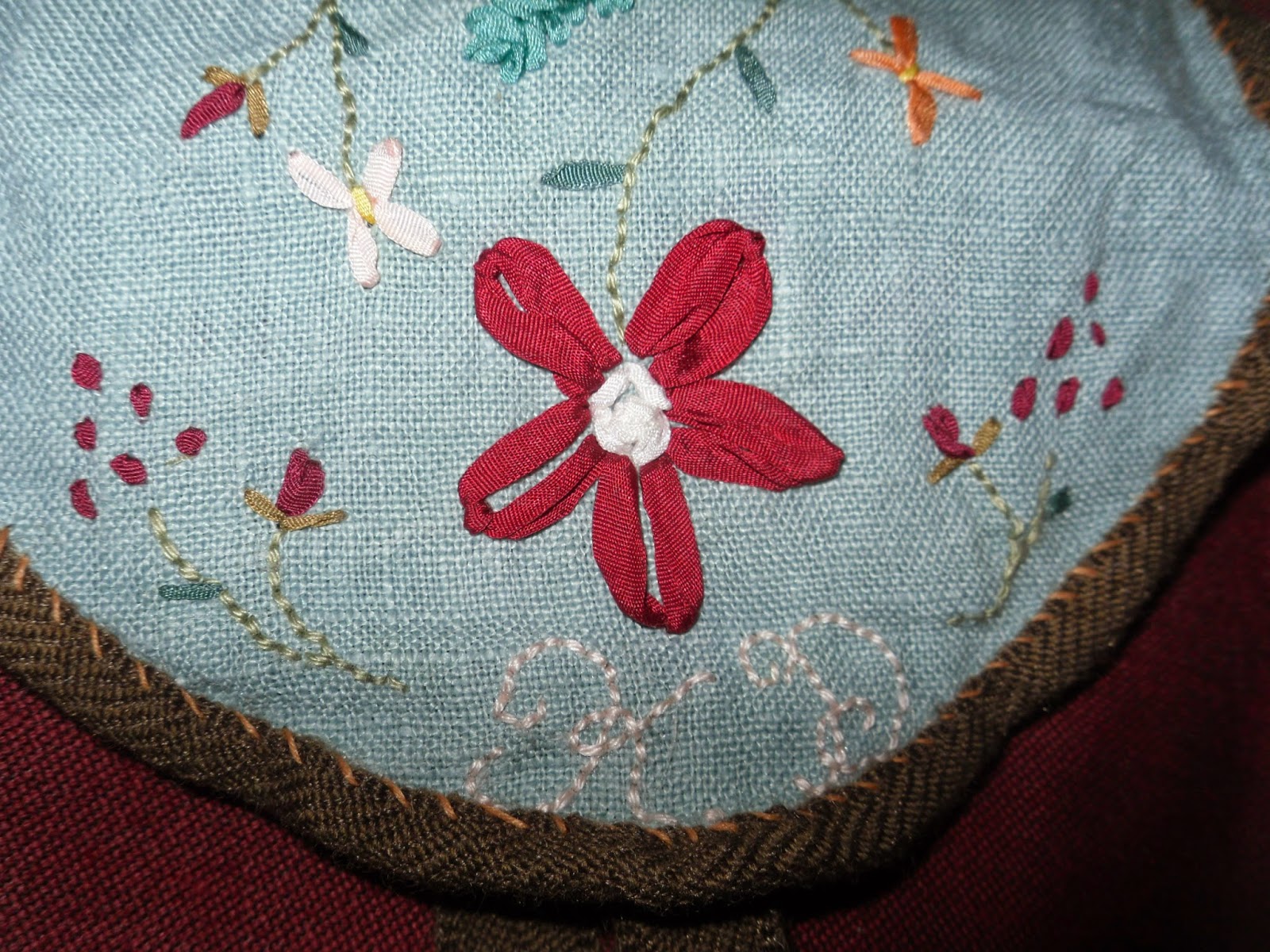I used period appropriate scrap materials that I had on hand to work my housewife out of. The lining and outer piece are both of a pretty blueish green linen. I've used brown wool scraps for the needle book and attached pin cushion (stuffed with wool roving, of course, no polyester fiberfill here!) The edges are bound with brown wool twill tape, which also creates the tie to hold it closed. Some small amounts of the hand sewing were completed with a green/blue silk thread while most were finished instead with a pinkish linen thread.
Women also were known to use embroidery to decorate such items. Often times more as a practice piece to help hone their skills for other household items. I drew my inspiration from "18th Century Embroidery Techniques" by Gail Marsh. Specifically "a silk needlecase decorated with ribbon-work flowers and leaves. Gawthorpe Hall, Lancashire, UK" pictured on page 15. Also a second silk needlecase with ribbon-work, also from Gawthorpe Hall pictured on page 165. I used the general sway of the flower stems and types as inspiration for an appropriate type of decoration. I worked my design all by hand (as with the whole case) in silk threads and silk ribbons.
The housewife has three pockets, a sewn in needle book and pin cushion as well as twill tape attachment for holding the scissors securely at the ready.
The wool "pages" to hold the needles and pins. Here are some purchased reproduction 18th century pins.
The needles are held at the top. Below you can see the green silk thread I used to hem the edges of the inner pockets.
This is the attached pin cushion made of wool and filled with wool roving. It isn't stuffed too tightly so that the housewife still folds up to be relatively flat.
Some of the bone/horn thread winders with black and white linen threads and brown and green silk embroidery threads. At the bottom you can see that I also used the brown twill tape to secure the bottoms of each pocket. This was for a nice neat finish as well as a little extra strength across the bottoms of the pockets
Here are the contents of the middle pocket. Some more bone thread winders with silk embroidery threads and also a fancy horn winder with silk sewing thread. A wonderful hand labeled linen tape measure. You can also see the small reproduction embroidery scissors tied to the outside of the pocket.
The bottom pocket holds a molther of pearl edged beeswax holder as well as a bone stiletto and bodkin. To me my stitching on that brown twill tape looks fantastic in this picture, if I do say so myself. I swear it isn't machine though. All hand stitched. I promise.
Here is the lot that I currently keep housed in the housewife. Some all purpose threads as well the silk embroidery threads in the colors I am currently using on another project.
The full view of the silk ribbon-work embroidery.
You can see that I used whipstitch to hold down the twill tape binding on the outside. Here you can see the date I embroidered on it. 1743. Of no particular importance, just a date I choose in the 18th century. I wanted a date sometime around the 40's-50's, and quite liked the look of the 4 and the 3. Of interest I have since become a fan of the Outlander series and 1743 is the year Claire is transported to back in time in Scotland. A nice little coincidence for me.
The stems are stitched (backstitch) with a green silk thread. The leaves and flowers are all silk ribbons. Here peach and pale pink flowers with yellow centers and green leaves.
The embroider continues on to show burgundy buds and large flowers in shades of deep red. There are also some larger leaves in various shades of green. I used different shades to add some depth and interest to the piece.
Here you can see close up some of the ribbon-work.
The design ends at the top with a single large flower and then the edge (upside down in comparison to the rest, but right side up when the pouch is folded) are my initials (K.D.) as well as buds and small red berry clusters on either side.
The pouch all folded up.
And tied with a bow.
Not held in my housewife but here are also my wooden awl and needle case. I added the silk ribbon and silk tassel (also two glass beads) to the needle case. It can slip over my wrist.
As you can see from the images the pattern is quite simple and I just made it up as I went. Simple rectangles of various sizes sewn together to create the correct size and shape I wanted. And that, my friends, is the beginning of my 18th century sewing kit!
SUPPLIES SOURCES:
Wool fabric: JoAnn Fabrics
Linen fabric: Fabrics Store
Wool Twill Tape, Linen thread, Assorted thread winders, bone stiletto, bone bodkin, waxer, rosewood needlecase: Wm. Booth, Draper
Assorted thread winders, including the fancy horn one: The Scarlet Scarab
Assorted thread winders and reproduction embroidery scissors, reproduction pins: Burnley & Trowbridge Co.
Linen measuring tape: A Fashionable Frolick
Hand dyed silk embroidery threads (not used, pictured on the winders), wood awl: Hedgehog Handworks (no affiliation, but I love the store and approve of the name!)
Additional silk threads are Gutterman silk, Kreinik silk and the ribbons are bulk from ebay.

















